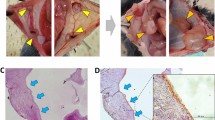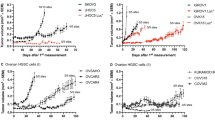Abstract
p53 gene alterations correlate highly with advanced ovarian carcinoma in women. In mice, p53 deficiency predominantly results in the formation of lymphomas and sarcomas. However, ovarian epithelial tumors have not been documented in p53 homozygous mutant (p53−/−) mice, probably because they die before other tumors can form. To determine whether p53−/− ovaries can develop epithelial tumors, they were transplanted into the ovarian bursae of histocompatible wild-type recipient females. The p53−/− ovarian grafts formed tumors ∼1 year post-transplantation. The tumor type was angiosarcoma, suggesting that vascular tissues are predisposed to tumor formation in p53−/−ovaries. These findings suggest that p53 deficiency alone is not sufficient for ovarian epithelial tumorigenesis in mice. Thus, other genetic lesions are likely required to develop mouse models of human ovarian cancer.
This is a preview of subscription content, access via your institution
Access options
Subscribe to this journal
Receive 50 print issues and online access
$259.00 per year
only $5.18 per issue
Buy this article
- Purchase on Springer Link
- Instant access to full article PDF
Prices may be subject to local taxes which are calculated during checkout



Similar content being viewed by others
References
Auersperg N, Wong AS, Choi KC, Kang SK and Leung PC . (2001). Endocr. Rev., 22, 255–288.
Bast Jr RC and Mills GB . (2000). Ovarian Cancer: Methods and Protocols Bartlett JMS (ed). Humana Press: New Jersey, pp. 37–48.
Blackburn AC, Brown JS, Naber SP, Otis CN, Wood JT and Jerry DJ . (2003). Cancer Res., 63, 2364–2368.
Chen CM and Behringer RR . (2004). Genes Dev., 18, 320–332.
Donehower LA, Harvey M, Slagle BL, McArthur MJ, Montgomery Jr CA, Butel JS and Bradley A . (1992). Nature, 356, 215–221.
Flesken-Nikitin A, Choi KC, Eng JP, Shmidt EN and Nikitin AY . (2003). Cancer Res., 63, 3459–3463.
Jacks T, Remington L, Williams BO, Schmitt EM, Halachmi S, Bronson RT and Weinberg RA . (1994). Curr. Biol., 4, 1–7.
Jemal A, Murray T, Samuels A, Ghafoor A, Ward E and Thun MJ . (2003). CA Cancer J. Clin., 53, 5–26.
Jylling AM, Jorgensen L and Holund B . (1999). Pathol. Oncol. Res., 5, 318–319.
Kuperwasser C, Hurlbut GD, Kittrell FS, Dickinson ES, Laucirica R, Medina D, Naber SP and Jerry DJ . (2000). Am. J. Pathol., 157, 2151–2159.
Mohr U (ed). (2001). International Classification of Rodent Tumors: The Mouse. Springer-Verlag: Berlin.
Nagy A, Gertsenstein M, Vintersten K and Behringer RR (eds). (2003). Manipulating the Mouse Embryo: A Laboratory Manual. Cold Spring Harbor Laboratory Press: New York.
Naka N, Tomita Y, Nakanishi H, Araki N, Hongyo T, Ochi T and Aozasa K . (1997). Int. J. Cancer, 71, 952–955.
Nucci MR, Krausz T, Lifschitz-Mercer B, Chan JK and Fletcher CD . (1998). Am. J. Surg. Pathol., 22, 620–630.
Orsulic S, Li Y, Soslow RA, Vitale-Cross LA, Gutkind JS and Varmus HE . (2002). Cancer Cell, 1, 53–62.
Platt JS, Rogers SJ, Flynn EA and Taylor RR . (1999). Gynecol. Oncol., 73, 443–446.
Purdie CA, Harrison DJ, Peter A, Dobbie L, White S, Howie SE, Salter DM, Bird CC, Wyllie AH, Hooper ML and Clarke AR . (1994). Oncogene, 9, 603–609.
Schuijer M and Berns EMJJ . (2003). Hum. Mutat., 21, 285–291.
Shelling AN, Cooke IE and Ganesan TS . (1995). Br. J. Cancer, 72, 521–527.
Turusov VS and Mohr U (eds). (1994). Pathology of Tumours in Laboratory Animals. Vol II – Tumours of the Mouse 2nd edn, IARC Scientific Publications no. 111. International Agency for Research on Cancer: Lyon, France.
Venkatachalam S, Tyner S and Donehower LA . (2002). Tumor Models in Cancer Research Teicher BA (ed). Humana Press: New Jersey, pp. 247–261.
Zietz C, Rössle M, Haas C, Sendelhofert A, Hirschmann A, Stürzl M and Löhrs U . (1998). Am. J. Pathol., 153, 1425–1433.
Acknowledgements
This work was supported by a Development Grant from the National Cancer Institute Specialized Programs of Research Excellence in Ovarian Cancer (CA83639) and grants from the National Institutes of Health (NIH) (HD30284) and Department of Defense Ovarian Cancer Research Program (OC020187) to RRB. Veterinary resources were supported by the NIH Cancer Center Support (Core) Grant CA16672.
Author information
Authors and Affiliations
Corresponding author
Rights and permissions
About this article
Cite this article
Chen, CM., Chang, JL. & Behringer, R. Tumor formation in p53 mutant ovaries transplanted into wild-type female hosts. Oncogene 23, 7722–7725 (2004). https://doi.org/10.1038/sj.onc.1208037
Received:
Revised:
Accepted:
Published:
Issue Date:
DOI: https://doi.org/10.1038/sj.onc.1208037
Keywords
This article is cited by
-
Nuclear envelope structural defect underlies the main cause of aneuploidy in ovarian carcinogenesis
BMC Cell Biology (2016)
-
Thymic epithelial β‐catenin is required for adult thymic homeostasis and function
Immunology & Cell Biology (2013)



